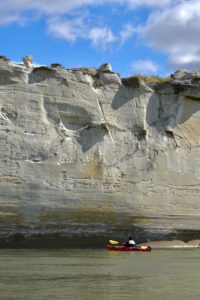 Rocks are lively, dynamic, and bearers of history. This was certainly never a thought that crossed my mind until I abandoned old perspectives and simply sat among them. With my college education rooted deeply in Western science, and working toward a degree in Fisheries and Wildlife Management, unbeknownst to me, my mind became rooted in this realm of Western thought, and our constant demand for knowledge from the natural world. According to Robin Wall Kimmerer, a Native American scientist with a specialty in Bryology, Western Science perpetuates the disconnect between humans and the natural world. We constantly demand information from our natural counterparts, and need to take the time to stop and listen (Kimmerer 29). She “think[s] of [her] own research as an interview process, a conversation” (Kimmerer 30).
Rocks are lively, dynamic, and bearers of history. This was certainly never a thought that crossed my mind until I abandoned old perspectives and simply sat among them. With my college education rooted deeply in Western science, and working toward a degree in Fisheries and Wildlife Management, unbeknownst to me, my mind became rooted in this realm of Western thought, and our constant demand for knowledge from the natural world. According to Robin Wall Kimmerer, a Native American scientist with a specialty in Bryology, Western Science perpetuates the disconnect between humans and the natural world. We constantly demand information from our natural counterparts, and need to take the time to stop and listen (Kimmerer 29). She “think[s] of [her] own research as an interview process, a conversation” (Kimmerer 30).
Having been exposed to Kimmerer’s perspective in section one of our four-part semester, we took these ideas with us as we embarked on our second section on the Missouri River. When my classmates and I began our kayaking trip down the river, I was astounded by the liveliness and the history I saw emanating from the stark white Virgelle Sandstone cliffs erupting alongside the river banks. Our very first day on the river we were awed by an aerial show put on by two bald eagles attempting to steal a fish from the talons of a lone osprey. As we struggled against the pull of the river, paddling upstream to get a better view at the powerful scene, we watched in a speechless stupor as the powerful birds careened above our heads. Screeching and embodying the deepest aspects of movement and life, the eagles performed what seemed to be acrobatics in the contrastingly dull, overcast Montana sky.
After a few days of paddling, we were finishing up a day hike, scrambling through slot canyons and crumbling sandstone when we took a minute to simply connect with the scenery. My classmates and I clambered up a slope of rock and each found a place to sit atop the stone, while the wind blew relentlessly against us. As I sat among the powdery white sandstone, open to the conversation it had to offer, I contemplated these bald eagles that we had witnessed a few days prior, and their harrowing contrasts to the sandstone I had grounded myself upon. Yet more importantly, I was struck by their shocking similarities.
Sitting in my nook in the sandstone, which felt almost perfectly crafted for me, I realized I felt the same sense of my minute reality among presences that dominated and loomed far above my head. Focusing on my senses, and on the concept of phenomenology – or the pure experience of a specific thing – I began to feel that the sandstone rose up from the Earth around me, from miles below my feet to picturesque white spires. I realized it was even more alive than those bald eagles which had astounded me with their incredible acrobatic grandeur days before.
In my mind, I understand that the eagles are not stagnant in their evolutionary history any more than these rocks are; yet I am struck with the transparency and willingness with which the sandstone shares its history with me.
As I gazed upon the landscape, I saw in the past, admiring divots and spires, caves and pockets that granted me insight into this rock’s historical relationship with the land and the erosional forces that have touched it. This ability to see millions of years of erosion and history that brought this sandstone to its current state of existence is a valuable reminder that the rocky throne I sat atop was nothing of the sort. If anything, I was subject to this massive expanse of sandstone’s every whim. Although, unlike humans, the rock is content to sit silently with this power, domineering merely in stature instead of attitude.
Certainly, this is a concept that is of some value to humans as a species, as our impact, for better or for worse, is evident in every landscape we occupy. Whether we look at the erosional forces of generations of people that shape footholds in the sandstone, the historical petroglyphs carved from disparate cultures, or even a teenager chipping his name into the sandstone, it is inarguable that humans are a domineering force on the natural world. All of this conceptualizing of the world around me is rooted in my conversation with the sandstone.
Of course, no words were exchanged. Instead, I focused my senses on the experience of the rock, and pushing aside my closely held convictions, I was able to behold it as something worth listening to, and worth protecting. Loren Eisley, author of the essay “The Flow of the River”, puts it this way: “…these sensations are not unique; but they are hard to come by; and the sort of extension of the senses that people will accept when they put their ear against a sea shell, they will smile at in the confessions of a bookish professor” (Eisley 17).